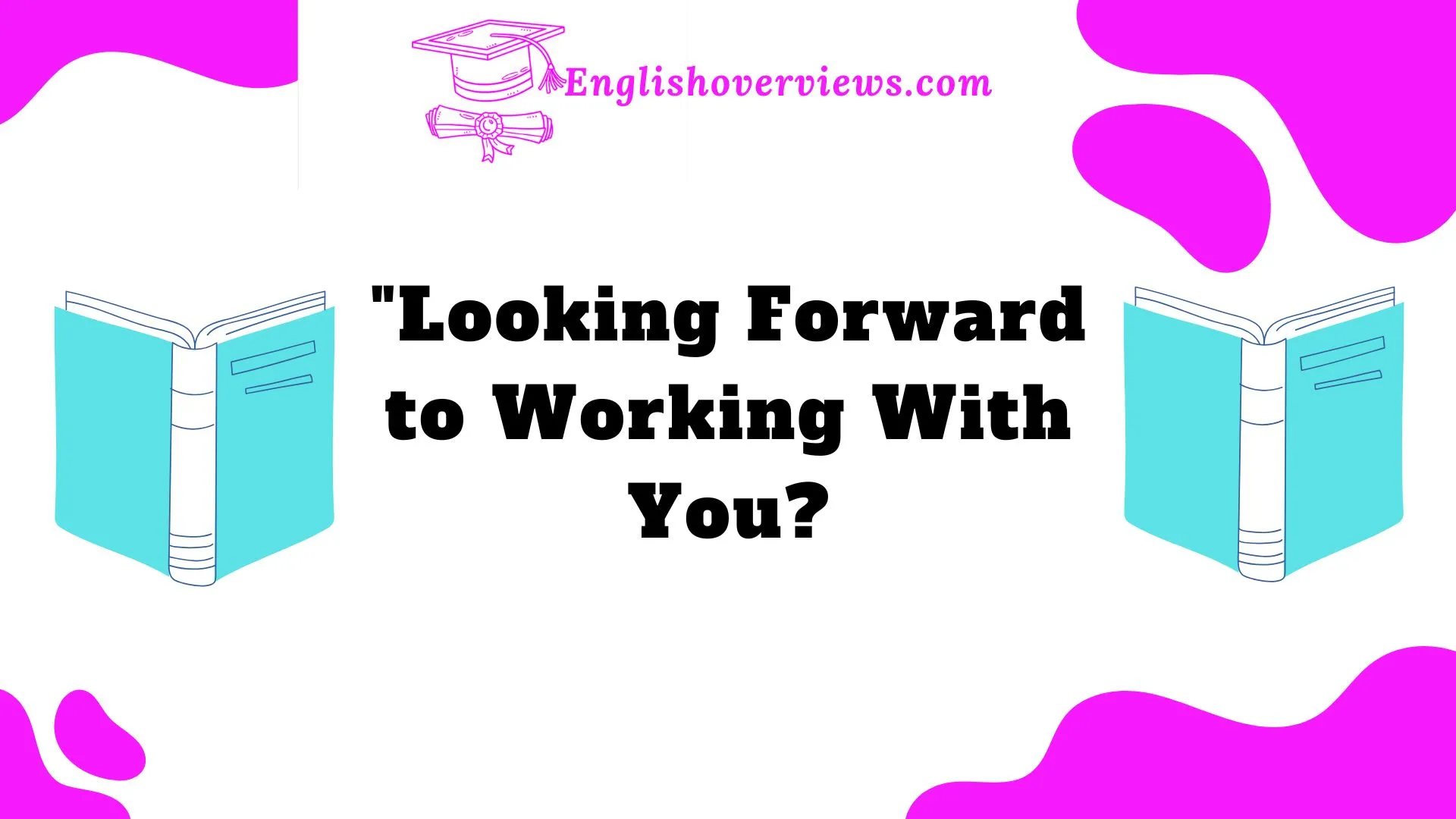When it comes to professional communication, phrases like “looking forward to working with you” can often sound friendly and positive. But is it really the best choice? Is it grammatically correct? Does it fit the tone of your message or your workplace culture?
These are the kinds of questions that can leave you wondering if there’s a better way to express enthusiasm about future collaborations.
In this post, we’ll dive into the proper usage of “looking forward to working with you,” break down the grammar behind it, explore when it’s appropriate, and even look at some better alternatives for different contexts.
Whether you’re drafting an email to a colleague, a client, or a new business partner, this guide will help you decide whether or not this phrase is the right fit for your professional communication.
1. Understanding the Phrase: “Looking Forward to Working With You”
Breaking Down the Phrase
Before we dive into the do’s and don’ts of using “looking forward to working with you,” let’s first break down the phrase itself. It might sound simple, but there are a few nuances that can help us understand its place in professional communication.
The phrase “looking forward to” expresses anticipation or eagerness. It’s often used when you’re expecting something positive in the future, and it pairs naturally with the action of working together. The preposition “to” is crucial here, as it connects the verb “looking forward” with the noun “working.”
In general, this is a grammatically correct expression, but be careful not to drop the preposition “to” or mix it up with a simple “looking forward work with you,” which is incorrect.
Is It Grammatically Correct?
Yes, “looking forward to working with you” is grammatically correct. The phrase uses future tense to express anticipation and collaboration. It’s a typical structure in business communication, especially when you’re about to start a project or build a new professional relationship.
Here’s a quick tip to ensure you’re using it right:
- Correct: “I’m looking forward to working with you.”
- Incorrect: “I’m looking forward work with you.”
The key is the preposition “to”, which you must include. Skipping it makes the phrase sound incomplete.
2. Contextualizing the Phrase: When Is “Looking Forward to Working With You” Appropriate?
Professional Communication and First Impressions
When you’re trying to make a positive first impression, “looking forward to working with you” can be a great choice. It shows you’re eager, enthusiastic, and committed to collaborating.
Using this phrase when you’re starting a new role, joining a project, or sending an introductory email sets the tone for a cooperative relationship.
That said, it’s important to understand when it’s the right choice. Here are some cases when it’s appropriate:
- In emails introducing yourself to a new team or client
- When you’re confirming future collaborations
- After a successful meeting to express eagerness for the next steps
In these cases, the phrase conveys professionalism with a touch of friendliness, making you appear both engaged and approachable.
When Not to Use It
On the other hand, there are situations where “looking forward to working with you” might not be the best fit. Here are a few examples:
- In formal business correspondence, like proposals or legal documents, where a more neutral tone is needed.
- When the relationship has not yet been established, and the phrase could sound too presumptuous or overly eager.
Instead of using “looking forward to working with you” in these cases, consider a more formal alternative, such as:
- “I look forward to our discussion.”
- “I anticipate the opportunity to collaborate.”
These alternatives maintain professionalism without overstepping boundaries.
3. The Tone and Impressions Created by “Looking Forward to Working With You”
Positive Impressions
The tone of “looking forward to working with you” is generally positive and enthusiastic, making it a popular choice in emails and messages where you’re establishing a relationship. It creates an impression of openness, cooperation, and team spirit.
Here’s how it works in different professional contexts:
- With a new colleague: It shows you’re ready to collaborate and contribute to the team’s success.
- With a client: It conveys a sense of commitment and readiness to begin working together on their needs.
Potential Pitfalls
However, while it’s friendly, it can also seem too casual or overly familiar in certain contexts. If you’re writing to a senior executive or someone you haven’t worked with before, the phrase might come across as too eager.
In such cases, toning it down a bit with more neutral phrases like “I look forward to our collaboration” may be a better fit.
4. The Formality of “Looking Forward to Working With You”
Is It Too Casual for Formal Settings?
Although “looking forward to working with you” is widely accepted in professional emails, it may not be formal enough for every situation. If you’re dealing with high-level corporate or governmental communications, you may want to avoid this phrase in favor of more formal alternatives.
Consider this comparison:
| Context | Example |
| Formal Business Communication | “I look forward to working with you on this matter.” |
| Casual/Standard Business Communication | “I’m looking forward to working with you soon!” |
| Professional but Neutral | “I look forward to collaborating with you.” |
As you can see, “looking forward to working with you” is appropriate for day-to-day business but might not convey the level of formality required in more serious or high-stakes settings.
5. Crafting the Perfect Closing for Business Communications
Best Practices for Business Emails
When closing an email, it’s important to match your closing phrase with the overall tone of your message. If you’re sending a thank you email or following up after a meeting, “looking forward to working with you” is a great way to signal your enthusiasm. Here’s how to craft the perfect business email close:
- Friendly Email Close
“Looking forward to working with you and hearing your thoughts.” - Formal Email Close
“I look forward to our continued collaboration.” - Thank You Email Close
“I’m eager to work together and take the next steps.”
In each example, the phrase “looking forward to working with you” or its variations add a tone of enthusiasm and commitment.
6. Real-Life Examples of Using “Looking Forward to Working With You”
Introducing Yourself to a New Team or Collaborator
When you’re entering a new role or starting a new project, using “looking forward to working with you” can help set a collaborative tone. Imagine this:
“Hi John, I’m excited to join the team and look forward to working with you on this upcoming project. I believe we’ll achieve great results together!”
This type of message is warm, positive, and demonstrates a strong team mindset.
As a Sign-Off in Business Emails
Here’s an example of how you might use the phrase in an email:
“I enjoyed our conversation today and am looking forward to working with you on this project. Let’s touch base next week to discuss the details.”
In this context, the phrase signals eagerness to continue the conversation and move forward with the next steps.
7. Exploring Synonyms for “Looking Forward to Working With You”
If you want to mix things up or convey a different tone, here are some alternatives:
- Eager to collaborate
- Excited to partner with you
- Anticipating our work together
- Keen to start this journey with you
- Ready to join forces
Each of these phrases communicates enthusiasm while offering a slightly different nuance. For example, “eager to collaborate” sounds more enthusiastic, while “anticipating our work together” has a more formal tone.
8. The Impact of “Looking Forward to Working With You” on Professional Relationships
Fostering Collaboration and Cooperation
By using a phrase like “looking forward to working with you,” you’re setting the stage for a collaborative and productive relationship. It conveys openness, showing that you’re approachable and ready to engage with others in achieving shared goals.
Long-Term Impact on Client or Colleague Relationships
In the long run, consistently expressing eagerness to collaborate can lead to stronger relationships. When your communication conveys optimism and a team-oriented approach, people are more likely to trust you and want to work with you again.
9. Conclusion
In conclusion, “looking forward to working with you” is a widely accepted and grammatically correct phrase for professional communication, offering an enthusiastic tone that fosters positive relationships. However, be mindful of when and where you use it, as it may not always suit high-level or formal correspondence.
Ultimately, finding the right balance between professionalism and friendliness will ensure your communication remains effective. So next time you’re drafting an email, consider if “looking forward to working with you” fits the context, or if another phrase might better suit your needs.
FAQs
Q1: Is “looking forward to working with you” too casual for a formal email?
It depends on the context. For formal business correspondence, you may want to use a more neutral phrase like “I look forward to collaborating with you.”
Q2: Can I use this phrase in job interviews?
Yes, it’s a great way to show enthusiasm after an interview or when following up with potential employers.
Q3: What are some alternatives to “looking forward to working with you”?
Alternatives include “Eager to collaborate,” “Excited to partner with you,” or “Anticipating our work together.”

English Overviews is a resourceful website dedicated to providing valuable content related to grammar and vocabulary. Muhammad Haroon has made notable contributions, sharing insights on various subjects, including WordPress themes and plugins. The primary goal of the site is to help users improve their English language skills effectively.











